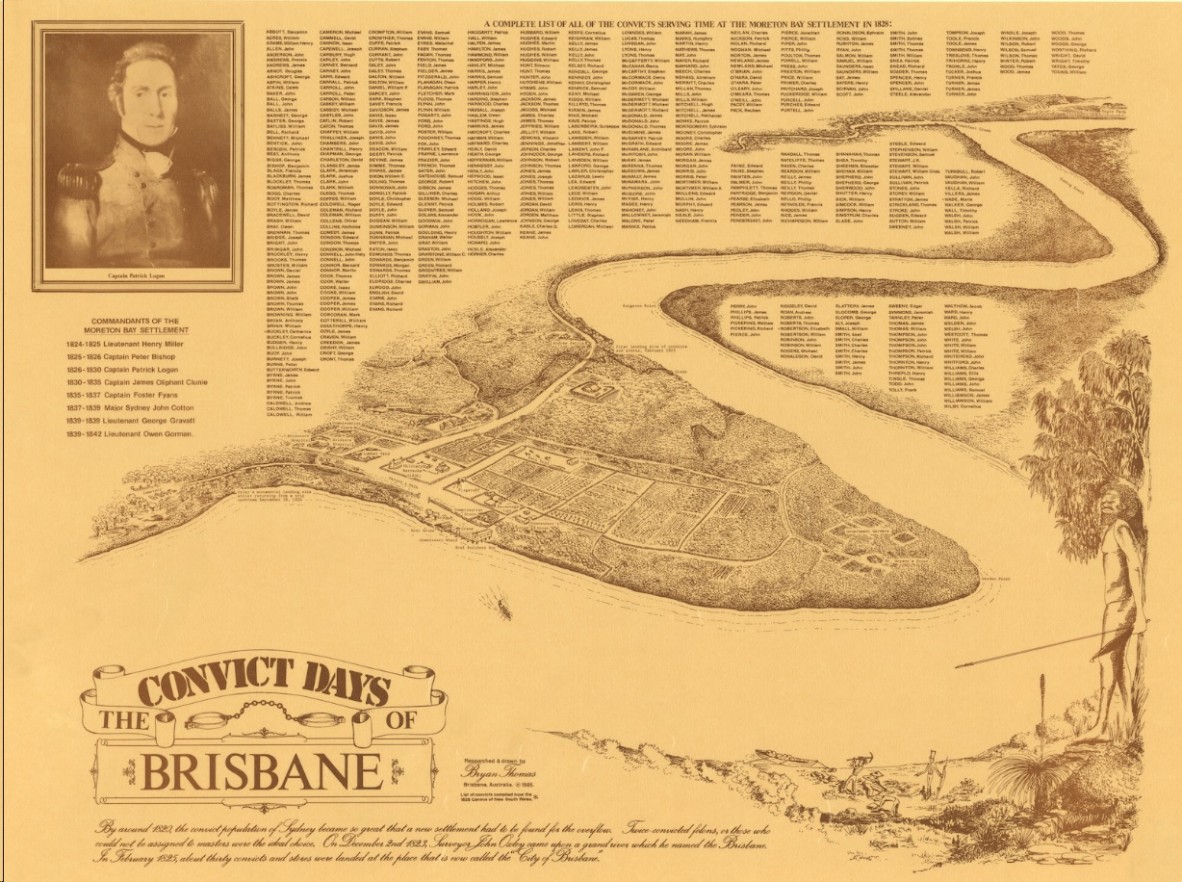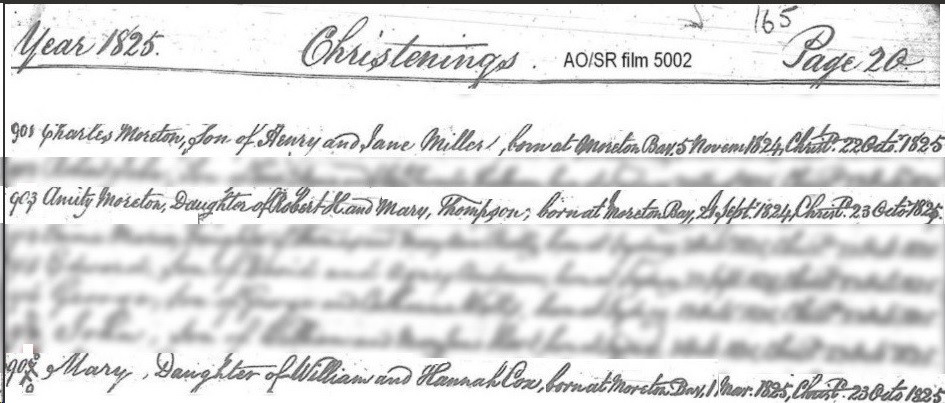Early records of births and deaths at Moreton Bay
By Stephanie Ryan, Research Librarian, Information and Client Services | 26 April 2024
The Moreton Bay settlement was established in September 1824 as an open, escape-proof gaol, in trying semi-tropical conditions, for secondary offenders, largely of British origins. These criminals, having been transported to Australia, had reoffended. While there was little comfort or work in the place, it is perhaps surprising in a time of pervasive, and often intense religiosity, that there were no clergy for spiritual rehabilitation. As clergy recorded the births and deaths of named individuals as baptisms and burials, not just numbers, there are significant gaps in these early records.
1824-25: first Moreton Bay births and baptisms
To understand the early history of Moreton Bay it is important to know that it was part of the colony of New South Wales. Therefore, records for the period to the end of 1859 are held in NSW. Many, but not all, were passed to Queensland after 1859. The earliest records of Moreton Bay births and baptisms are held in NSW but are not in the Queensland Registry records. These record the births of the first 3 children born at Moreton Bay (Humpybong, Redcliffe) in 1824–1825: Amity Moreton Thompson, Charles Moreton Miller and Mary Cox. The babies, all soldiers’ children, were baptised later in Sydney in 1825 when the regiment was there briefly.
1827: Archdeacon, T Scott in Brisbane but Moreton Bay church records kept in Sydney
In 1827 Thomas Hobbes Scott, Anglican Archdeacon of NSW, visited Moreton Bay and performed baptisms and burials.
On 19 June 1827, there were 4 baptisms of children all born in 1826, including that of Letitia Bingham Logan, daughter of the Commandant, Patrick Logan. With one exception their fathers were soldiers. In the period from November 1824 to May 1827, 16 burials were recorded. Two were not convicts, an 18-month-old child, Joseph Curry, and a soldier, Phelix O’Neil. Apart from their names, the 14 convicts were not identified by any personal information such as their age or place of origin. Only their transport ship was listed. On 7 July 1827 William Cowper, in charge of St Philip’s, Sydney, directed that Scott’s baptisms and burials be entered into the records of that church, not into a separate register for Moreton Bay. Therefore, the records can be found only in the NSW Registry.

The convict days of Brisbane researched & drawn by Bryan Thomas, c1985, Image 503968-s0001
1829: The Rev. John Vincent’s appointment at Moreton Bay
In April 1829 John Vincent arrived in Brisbane, the first chaplain appointed to the settlement. However, in October 1829 Governor Darling removed him from Moreton Bay. In the intervening months he baptised 6 babies, born April 1828–October 1829. Four of them were soldiers’ children. Only 2 are recorded in Queensland Registry records, those born in Moreton Bay in 1829. Over the same time, he performed burial ceremonies for 29.
Vincent was unpopular with the Moreton Bay Commandant and the Sydney-based Bishop. In addition to requests for personal benefits, he wanted a church building for a thousand people with galleries for extra numbers, a larger school in a better situation and another burial ground site, as evidenced in the Colonial Secretary’s Correspondence (A2.3 pp 126-131, 155-161). He insisted on rigorous documentation for the burial of Michael Collins from Lieutenant Bainbrigge while Commandant Logan was temporarily absent, delaying the interment. He also challenged the authority of the Commandant by posting marriage banns for a former convict, Thomas Cribb, and his assigned convict, Ann Goodlake. He did so without the permission of the absent Commandant, ignoring the role of the Commandant’s temporary replacement, Lieutenant Bainbrigge, and in contravention of penal regulations. Logan’s response was swift, removing Thomas Cribb from Moreton Bay and emphasising to the Governor the need to recall Vincent which was done.
November 1829 to 1837: Moreton Bay baptisms and burials
By August 1829 new penal regulations required divine service every Sunday. Clergy were now important in convict settlements. Despite this new emphasis, it was not until 1837 that Lutheran-trained minister, Johann Handt, arrived in Brisbane, initially to convert local Aboriginal peoples but also to minister to convicts. His pastoral base was a room above the gaol, not the elaborate building Vincent had requested. He was the assistant to William Watson, ordained in the Church of England for the specific purpose of ministering to First Nations peoples. Both operated under the Church Missionary Society of the Church of England. Handt performed not only baptisms and burials but also the first two marriages in the settlement, the only two until it became a free settlement in 1842. For further detail on these marriages of free people in a convict colony, see The first marriages in the Moreton Bay settlement 1839: behind the records. Handt stayed at Moreton Bay until 1843 when John Gregor succeeded him. The German missionaries arrived in Brisbane in 1838. So, as the convict settlement neared its end unofficially in 1839, there was an established clergy presence in Brisbane.
Pre-1860: accessing births, deaths and marriages
The indexes of both the Queensland and NSW Registries of Births Deaths and Marriages are online into the 20th Century. State Library holds the original records of early events on microfilm in Register of baptisms, burials and marriages 1787-1856 [NSW Registry of Births, Deaths and Marriages]. Civil (government) records were introduced in March 1856. These are not available among the original church records on microfilm. From March1856–December 1859 it is still possible to check for Moreton Bay events on the NSW Registry indexes and perhaps find the place of an event in the church code, unavailable in the Queensland indexes, but it is not possible to get these later original records other than by requesting them from the NSW Registry and paying for them. While some Moreton Bay events were recorded only in NSW, others were identified when the Queensland Registry sifted the NSW collection searching for Moreton Bay material. There is also the complicating factor that as settlers dispersed throughout the sparse colonial regions, church and civil events were not always recorded. Thomas Bridges recalled in the Telegraph 3 October 1935 p12 that his family in 1853 were Baptists for whom there was no minister so he and many others were not registered.
According to the Queensland Registry website, their records for all events commence in 1829, some are earlier, marriages are later, and there are gaps. Because of the way records for Moreton Bay births and burials were recorded, it is essential to check both Queensland and NSW Registry indexes.
Find out more
- Check the Queensland Registry of Birth, Death and Marriage indexes using their Family History Research Service
- Check the NSW Registry of Birth, Death and Marriage indexes at Search my ancestry
- Find out more the Colonial Secretary’s Correspondence, search the indexes and learn about the project to digitise documents at Colonial Secretary's letters received relating to Moreton Bay and Queensland
- Explore the catalogue One Search for more on your subjects of interest.
More information
One Search catalogue – https://onesearch.slq.qld.gov.auopen_in_new
Library membership – https://www.slq.qld.gov.au/services/membership
Ask a librarian - https://www.slq.qld.gov.au/services/ask-librarian
Plan your visit – https://www.slq.qld.gov.au/visit
Comments
Your email address will not be published.
We welcome relevant, respectful comments.

![image of Register of baptisms, burials and marriages 1787-1856 [NSW Registry of Births, Deaths and Marriages]. showing baptisms from 1827](/sites/default/files/styles/slq_standard/public/Scott%20baptisms.jpg?itok=hY272a3K)
![Register of baptisms, burials and marriages 1787-1856 [NSW Registry of Births, Deaths and Marriages]. showing burials from 1929](/sites/default/files/styles/slq_standard/public/John%20Vincent%20burials.jpg?itok=BXjDwdLQ)